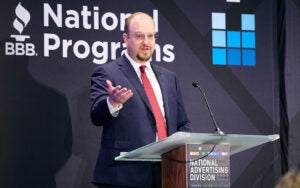“On TV & Video” is a column exploring opportunities and challenges in advanced TV and video.
Convergent TV isn’t just about marrying linear and streaming TV.
Linear has its own fragmentation challenges to solve, from local and national addressable to broadcast and cable. Ampersand – a TV sales consortium owned jointly by Comcast, Charter and Cox – is on a mission to patch the holes by corralling as much TV inventory as possible.
Ampersand sells local and multiscreen national spots, or campaigns that run in select local markets nationwide, as well as connected TV inventory. It doesn’t sell on national networks or broadcast, although data from those channels guides activation and measurement decisioning within the platform, said CEO Nicolle Pangis.
With a national TV footprint of 80 million US households and access to 70% of the national addressable marketplace, Ampersand sees itself as “sitting on the largest supply of linear inventory in the ecosystem,” Pangis said. “And these aren’t banner ads and cat videos; we’re talking premium television inventory.”
Pangis, who joined Ampersand (previously NCC Media) in 2018 after stints at GroupM and Xaxis, comes from a digital programmatic background, which she says guides Ampersand’s approach to technology.
That means providing a user interface that looks similar to the demand-side interfaces advertisers are used to in digital. “But it’s connected to premium television inventory that can be activated and streamlined directly by brands and agencies with the intelligence they glean from our platform,” she said.
Pangis spoke with AdExchanger.
AdExchanger: What’s the thread that ties together linear, addressable and streaming TV?
NICOLLE PANGIS: Audience-based buying. Moving from GRPs to audience buying is a huge, industry-wide shift.
Geotargeting surprised me when I moved from digital to television. On digital, geography is just the click of a button. I could move from a nationally targeted campaign to a fairly hyperlocal one with just a couple of clicks in an interface – but it’s not so simple for television.
AdExchanger Daily
Get our editors’ roundup delivered to your inbox every weekday.
Daily Roundup
In the TV space, there’s local and national, and there’s a very big difference between cable and broadcast on top of that. But the move toward audience-based media buying is blurring those lines.
Brands want to target the audience they want across all of these pieces as consistently as possible.
What is Ampersand’s approach to unifying TV?
Better technology and better integrating into agency-side tools. We, and others, are starting to offer buyers holistic views across their total media investments.
We want to make activation as seamless as possible on the buy side. Within our platform, we have broadcast insights we can measure from a local, national and streaming perspective across 42 million households of data to determine frequency and incremental reach.
We’re also working with all the suppliers we represent in the marketplace to try and simplify the process on the backend. We’re integrated with more partners from both a measurement and attribution perspective, as well as from an agency perspective, than we were four years ago.
What is the TV industry’s biggest pain point on the path to convergence?
Historically, there have been linear TV buyers and digital buyers. But within addressable TV, there’s also a division between local and national buyers.
When it comes to converged TV, buyers need to look at the holistic television budget as a brand – not in siloes of linear and digital, and not in siloes of local and national. On the sell side, the technologies behind activation on linear are obviously very different than those used for digital delivery.
Successful TV ad campaigns now need to be multiscreen buys, meaning linear and streaming. As an industry, we’re in that evolution, but it takes work to get there.
Why do agencies draw a line between their national and local buys?
First, that is how agencies were organized. And a technology platform that allowed for buying both national and local in one place didn’t exist. The two worked in siloes.
But execution teams are starting to come together to look more holistically at TV investment budgets and where those ad budgets should be executed across channels.
That’s why we’ve built our platform as a single interface for buyers to choose national and large or small local campaign executions with a button and with the same data in the same fashion to get the same reporting across both, including frequency capping and incremental reach.
That means buyers can overlay national and broadcast campaigns that have nothing to do with what we do at Ampersand, and we can ingest that data and show buyers where they over- or under-indexed on audience delivery across their campaigns.
Is the industry overlooking the importance of addressable national and local linear and focusing too much on the hype swirling around streaming and alternate currencies?
Yes – I couldn’t agree more with that.
As an industry, we tend to shine a magnifying glass on one or two things without opening up the aperture of the lens as much as we should. We’re trying to keep our aperture open at Ampersand. The clients making the most progress with us are those who understand that streaming and measurement are only two components of the larger conversation around converged TV.
Making a delineation between linear addressable and streaming does our industry a disservice because the most responsible media buys capture as much insight about audiences as possible wherever they are.
There’s been discussion about seller-defined audiences, but based on what we see, it’s more brand- and agency-defined audiences at this point.
Why is that?
It depends on the marketplace, but this is what we’re seeing in the national addressable space.
Brands and agencies aren’t looking for every media vendor they work with to define audiences as they’d like to for their own delivery purposes from a supply-side standpoint. What advertisers are looking for is to create an audience definition and then push that definition out to their strategic partners to deliver on.
This interview has been edited and condensed.














